Cite this document
(“Review of Literature on Multicultural Literarture Dissertation”, n.d.)
Retrieved from https://studentshare.org/family-consumer-science/1421530-review-of-literature-on-multicultural-literarture
Retrieved from https://studentshare.org/family-consumer-science/1421530-review-of-literature-on-multicultural-literarture
(Review of Literature on Multicultural Literarture Dissertation)
https://studentshare.org/family-consumer-science/1421530-review-of-literature-on-multicultural-literarture.
https://studentshare.org/family-consumer-science/1421530-review-of-literature-on-multicultural-literarture.
“Review of Literature on Multicultural Literarture Dissertation”, n.d. https://studentshare.org/family-consumer-science/1421530-review-of-literature-on-multicultural-literarture.


